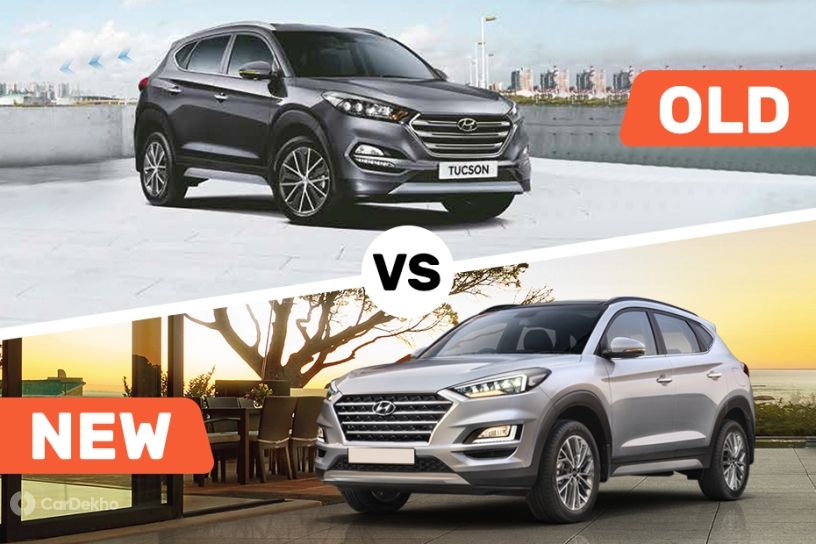Hyundai Tucson 2020: Old vs New
Published On Jul 16, 2020 10:01 AM By Sonny
- Write a comment
Hyundai’s flagship SUV in India has finally received an update. But how different is it from the its predecessor

Hyundai has launched the Tucson facelift in the country after showcasing it at the 2020 Auto Expo earlier this year. The carmaker’s flagship SUV gets a minor facelift with new BS6 engines and updated features. Let’s take a closer look to see just how different the 2020 Tucson is from the model it has replaced:
Dimensions
| Measurements |
Pre-facelift Tucson |
2020 Tucson |
| Length |
4475mm |
4480mm (+5mm) |
| Width |
1850mm |
1850mm |
| Height |
1660mm (w/ roof rails) |
1660mm (w/ roof rails) |
| Wheelbase |
2670mm |
2670mm |
| Boot space |
- |
530 litres |
-
Given that this is simply a facelift, the proportions of the Hyundai Tucson remain largely unchanged.
The only difference is the 5mm increase in length, which is a result of its cosmetic updates.


Exterior
-
The Tucson facelift is a mild one with the biggest change being the revised front fascia.
-
It gets a new cascading grille, front bumper and penta projector LED headlamps (5 LED projector units) and LED taillamps.
-
The 2020 Tucson also features a new design for its 18-inch diamond-cut alloy wheels and the dual-exit exhaust tips.
-
The rear end has been tweaked as well with a new rear bumper and the rear reflectors are now positioned much higher and is split-housed on the tailgate itself.


Interior & Features
-
The cabin of the facelifted Tucson gets an all-black interior as opposed to the outgoing model’s dual-tone beige and black cabin.
-
It has a redesigned dashboard with central AC vents positioned below the new free-standing 8.0-inch touchscreen infotainment system. The climate control panel seems unchanged.
-
Its auto-dimming IRVM gets added buttons for the Hyundai BlueLink connected car technology features.
-
In the Tucson, BlueLink allows the owner a series of remote functions such as engine start/stop, cabin pre-cooling and door lock/unlock. It also features voice command capabilities for many functions.

-
The top Hyundai SUV offering in India continues to get features like premium leatherette upholstery and a panoramic sunroof.
-
It also continues to offer comforts like wireless charging, drive mode select, an electronic parking brake and adds a tyre pressure monitoring system to the LCD multi-information display in the instrument cluster. Yes, the Tucson misses out on a digital instrument cluster.
-
The new Tucson features an 8-speaker Infinity premium sound system which is an upgrade over the outgoing model’s 6-speaker sound system.
-
Hyundai continues to offer the Tucson with 6 airbags, front and rear parking sensors, vehicle stability management, downhill brake control and electronic stability control as part of the safety equipment. Since the deletion of the entry-level variants, these features (apart from front parking sensors) are now standard in the new Tucson.

Engines
Hyundai has not changed the engine lineup for the facelifted Tucson and still offers it with 2.0-litre petrol and diesel engines, albeit with updates to meet BS6 norms.
Petrol
| Old |
New |
|
| Engine |
2.0-litre |
2.0-litre |
| Power |
155PS |
152PS |
| Torque |
192Nm |
192Nm |
| Transmission |
6-speed MT/ 6-speed AT |
6-speed AT |
-
The updated BS6 petrol engine makes 3PS less than before.
-
Hyundai has discontinued the more affordable variants and thus the manual transmission option as well. It is now only offered with the 6-speed automatic.
Diesel
| Old |
New |
|
| Engine |
2.0-litre |
2.0-litre |
| Power |
185PS |
185PS |
| Torque |
400Nm |
400Nm |
| Transmission |
6-speed MT/ 6-speed AT |
8-speed AT |
-
The BS6 diesel engine offers the same performance as before.
-
However, it gets a new 8-speed automatic transmission to replace the 6-speed automatic while the 6-speed manual variants of the Tucson have been discontinued.

Prices
Hyundai has discontinued the more affordable L and GL variants of the Tucson with the new facelifted model. As a result, the entry point for a Tucson has gone up by Rs 3.53 lakh. The variant-wise prices are as follows (ex-showroom Delhi):
Petrol
| Variant |
Pre-facelift Tucson |
2020 Tucson |
Difference |
| L |
Rs 18.77 lakh |
N.A. |
- |
| GL |
Rs 21.87 lakh |
N.A. |
- |
| GL(O) |
Rs 22.47 lakh |
Rs 22.30 lakh |
Rs 17,000 (new Tucson is cheaper) |
| GLS |
Rs 23.74 lakh |
Rs 23.52 lakh |
Rs 22,000 (new Tucson is cheaper) |
Surprisingly, the GL(O) and GLS petrol variants are actually more affordable than before.

Diesel
| Variant |
Pre-facelift Tucson |
2020 Tucson |
Difference |
| L |
Rs 20.80 lakh |
N.A. |
- |
| GL |
Rs 23.64 lakh |
N.A. |
- |
| GL(O) |
Rs 24.24 lakh |
Rs 24.35 lakh |
Rs 11,000 (new Tucson is pricier) |
| GLS |
N.A. |
Rs 25.56 lakh |
- |
| GLS 4WD |
Rs 26.97 lakh |
Rs 27.03 lakh |
Rs 6,000 (new Tucson is pricier) |
Also read: 2020 Hyundai Tucson vs Rivals: What Do The Prices Say?
-
Hyundai still limits the 4WD option to the diesel-powered Tucson.
-
It is only slightly more expensive than before, which is a good deal given that the car now gets a lot more tech even if the feature list has not changed much.
-
The GLS variant is now available with the diesel engine unlike before where it was exclusive to the petrol engine option.
Read More on : Tucson Automatic
3 out of 3 found this helpful















